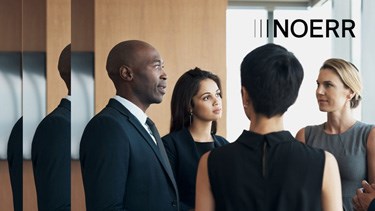Control or no control – UBOs and the transparency register
I. Introduction
Since 30 June 2022, legal entities have been required to actively report their ultimate beneficial owners to the transparency register (see our article from 17.06.2021). The previous option of relying on information already published from other public sources, in particular the commercial register, is no longer possible since that date.
This means that compliance with and fulfilment of this reporting obligation is becoming increasingly relevant in every company acquisition and every due diligence. If the company subject to the reporting obligation does not submit a required report to the transparency register, or does not submit it on time or in full, this is not considered a minor oversight but an administrative offence, which can be punished with a fine of up to €150,000 if committed intentionally. In addition, the Federal Office of Administration, as the register-keeping authority under section 57(1) German Anti-Money Laundering Act, publishes non-appealable decisions imposing fines on its website, stating the nature and character of the offence and naming the legal entities responsible for the offence. Notices remain public for five years.
II. Identifying the ultimate beneficial owner
Pursuant to section 3(2) sentence 1 German Anti-Money Laundering Act, any natural person who directly or indirectly (i) holds more than 25% of the capital shares, (ii) controls more than 25% of the voting rights or (iii) exercises control in a comparable manner is deemed to be the ultimate beneficial owner of a legal entity.
1. Direct participation
The first stage of the review begins with identifying the shareholders. This involves looking at the direct shareholding structure in the specific company subject to the reporting obligation. It may well be the case that several shareholders meet the requirements as ultimate beneficial owners.
Case study 1: If A-GmbH is held by two natural persons, A and B (70% and 30% respectively), both shareholders are ultimate beneficial owners of A-GmbH, as both exceed the threshold of 25%.
Variation: If, on the other hand, A-GmbH is held by three natural persons, A, B and C (60%, 30% and 10% respectively), then C alone does not fulfil the requirement in section 3(2) German Anti-Money Laundering Act, which is why only A and B must be reported as ultimate beneficial owners.
2. Indirect participation
According to the legal definition, the ultimate beneficial owner can only be a natural person. Therefore, if one of the shareholders is a legal entity, more detailed examination is required, namely to identify who controls that legal entity. In that case, the chain of shareholdings in the legal entity is analysed and a review is done at each level as to whether a natural person exercises indirect control pursuant to section 3(2) sentence 2 German Anti-Money Laundering Act. Regarding “controlling influence” on the legal entity, section 3(2) sentence 4 German Anti-Money Laundering Act refers to the provisions of section 290(2-4) German Commercial Code. Controlling influence exists, among other things, if the natural person controls the majority of the voting rights in a legal entity.
Case study 2: If two natural persons (A and B) each have a 30% share in A-GmbH and B-GmbH also has a 40% share, A and B are first identified as ultimate beneficial owners because they both exceed the threshold. In the second step, we examine who controls B-GmbH (within the meaning of section 290(2-4) German Commercial Code). For this purpose, the shareholders of B-GmbH must be identified. If B-GmbH has C (60%) and D (40%) as shareholders, C exercises a controlling influence over B-GmbH according to section 290(2) no. 1 German Commercial Code, since C holds the majority of the voting rights in B-GmbH. Thus, C indirectly controls A-GmbH, which is why B-GmbH’s 40% shareholding is attributed to it. In this situation, A and B must therefore be reported as the (direct) ultimate beneficial owners and C as the (indirect) ultimate beneficial owner of A-GmbH.
Variation: If C and D each hold B-GmbH on a parity basis, neither exercises a controlling influence over B-GmbH, and thus neither C nor D is to be regarded as an (indirect) ultimate beneficial owner of A-GmbH. Accordingly, only A and B are to be reported as ultimate beneficial owners of A‑GmbH.
III. Nature and extent of the beneficial interest
If the ultimate beneficial owner has now been identified at the various levels, certain information must be communicated pursuant to section 19(1) German Anti-Money Laundering Act, in particular the type and scope of the beneficial interest.
1. Specific percentage
According to the wording of the law, any natural person with more than 25% of the capital shares/voting rights is the ultimate beneficial owner. For each ultimate beneficial owner, the nature and extent of the beneficial interest must be disclosed. However, it is not clear from the wording of the law whether the specific percentage has to be stated or whether it is sufficient to simply state that the threshold of 25% is exceeded. If the latter were the case, the legal reporting requirements would be satisfied if the extent of the beneficial interest were merely stated as “> 25%”. On the other hand, the requirement to indicate a specific percentage currently results from the fact that it is not possible to submit a report to the transparency register without indicating a specific percentage. More information can be found in our article from 03.06.2022.
The interpretation becomes relevant whenever the shareholding of an ultimate beneficial owner changes without the ultimate beneficial owner’s position itself changing. If, in case study 1, A transfers 20% of its shareholding to B, so that both have a 50% shareholding in A-GmbH, according to the wording of the law no new report would have to be made to the transparency register, because nothing has changed in the position of A and B as ultimate beneficial owners (= more than 25%). From the point of view of the transparency register, however, a notification of change must be made because the (reported) shareholding amounts have changed.
2. Percentage for indirect control
In addition, indicating the beneficial interest in the case of indirect control causes difficulties, especially where the controlling shareholder does not hold 100% of the capital shares/voting shares. It should be noted that the existing percentage shareholdings are not multiplied, but that the amount of the shareholding in the controlled GmbH is directly attributed. This is because the controlling shareholder can control the full amount of the existing (sub-)participation.
If, as in case study 2, C holds 60% of B-GmbH, which in turn holds 40% of A-GmbH, C’s beneficial interest is not 24% (60% of 40%), but 40%. C is therefore the ultimate beneficial owner of 40% of A-GmbH.
Well
informed
Subscribe to our newsletter now to stay up to date on the latest developments.
Subscribe now








